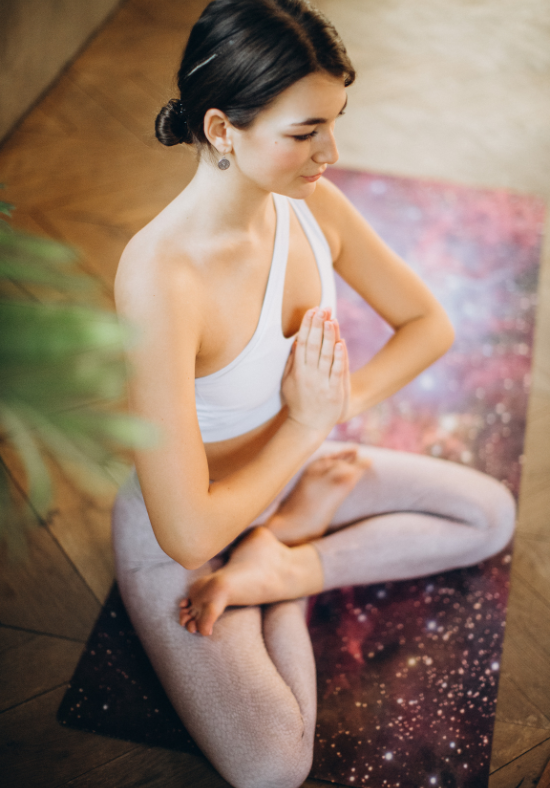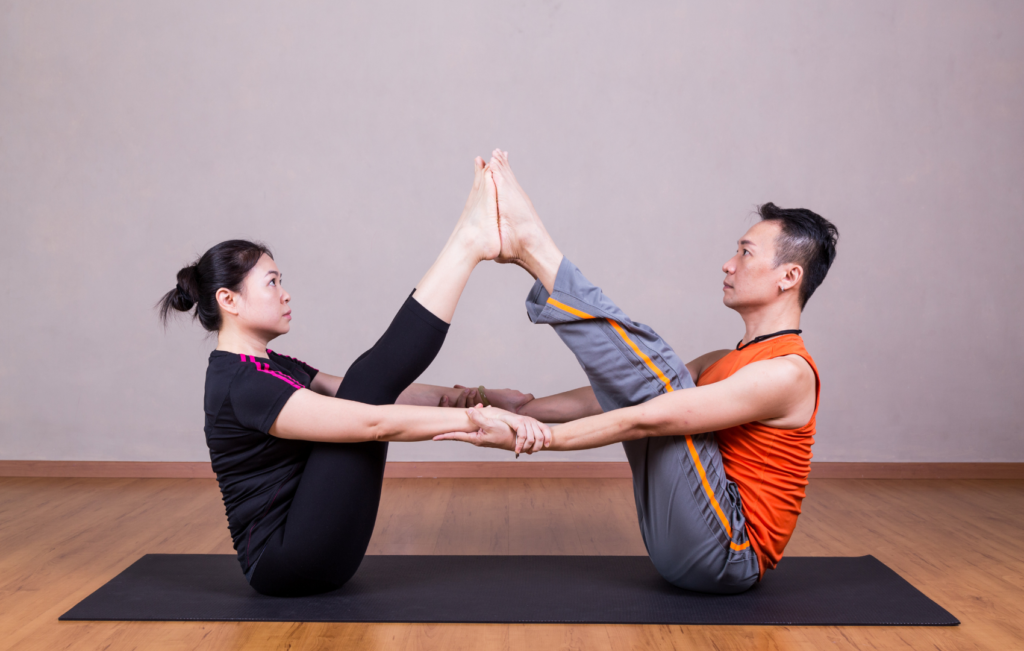Unlock The Mystery Of Losing Weight With Yoga (in 2023)
Are you tired of fad diets and quick weight loss solutions that don’t deliver lasting results? Discover the secret to losing weight and keeping it off with yoga in 2023.

Unlock the power of yoga to transform your body and mind. Read on to learn how yoga can help you achieve your weight loss goals.
In This Article:
I. Introduction
A Guide to the Definition of Yoga
Yoga is a Hindu philosophy and a system of exercises aimed at creating a union between the body, mind, and spirit, as well as between the individual self and universal consciousness.
The word yoga is derived from the Sanskrit root "yuj," meaning to yoke or unite.
It is defined as "a Hindu philosophy teaching that by holding back the activity of one's body, mind, and will one can know one's true self and be free," as well as "a system of exercises for gaining bodily or mental control and well-being".
By neutralizing ego-driven thoughts and behaviors, yoga can lead to a sense of spiritual awakening.

Calm Your Mind: The Miraculous Benefits of Yoga for Weight Loss
According to a study by Ross in 2010, yoga may be just as effective as exercise in improving a variety of health-related outcome measures.
This finding is particularly significant for those who may struggle with traditional forms of exercise or simply do not have the time for a regular workout routine. By practicing yoga regularly, you can reap the benefits of exercise without the need for intense physical activity.
A study by Lauche in 2016 found that yoga can be considered a safe and effective intervention for reducing body mass index in overweight or obese individuals.
This finding is particularly important for those who may struggle with weight loss, as it provides a safe and effective solution that can help to improve overall health and well-being.
According to a study by Chu in 2016, yoga can show significant improvement for body mass index, systolic blood pressure, low-density lipoprotein cholesterol, and high-density lipoprotein cholesterol.
These findings indicate that yoga can not only help you to lose weight, but also improve your overall health and well-being.
According to Rioux in 2013, therapeutic yoga programs are frequently effective in promoting weight loss and improvements in body composition.
This is due to the combination of physical activity and mindfulness that is inherent in yoga practice, which can help to increase overall calorie burn and improve body composition.
A study by Kristal in 2005 found that regular yoga practice is associated with attenuated weight gain.
This is due to the improved mindfulness and self-awareness that results from regular yoga practice, which can help prevent overeating and promote healthy food choices.
II. Understanding the Mind-Body Connection at the Heart of Yoga and Weight Loss

The Surprising Ways Yoga Aids in Achieving Weight Loss Goals
Yoga has been known to have multiple benefits for both physical and mental health, and weight loss is one of them.
The study conducted by (Ross, 2010) revealed that yoga has the potential to be just as effective or even more effective than traditional exercise in improving various health outcomes.
Yoga showed significant improvement in body mass index (0.77 kg/m2 (95% confidence interval 1.09 to 0.44)), systolic blood pressure (5.21 mmHg (8.01 to 2.42)), low-density lipoprotein cholesterol (12.14 mg/dl (21.80 to 2.48)), and high-density (Chu, 2020)
Another study conducted by (Raub, 2002) found that the practice of Hatha Yoga can enhance physical attributes such as strength and flexibility, while also having a positive impact on physiological factors such as blood pressure, heart rate, respiration, and metabolic rate.
These improvements can then result in an overall enhancement of exercise capacity.
Moreover, a study conducted by Yang in 2007 found that incorporating yoga into a weight loss regimen can be an effective way to reduce body weight.
The Vital Importance of Mind-Body Connection
The relationship between the mind and body is essential for achieving and maintaining good health and happiness.
The body and brain are connected through a complex network of neural pathways, composed of neurotransmitters, hormones, and other chemicals, which send signals that regulate our daily activities, from breathing and digestion to movement and cognition.
Astin's 2003 research findings showed that mind-body therapies have a proven track record of effectively treating a wide range of common clinical conditions.
Taylor's 2010 study revealed the strong link between the brain and the peripheral tissues, highlighting the important role that these bidirectional interactions play in maintaining both mental and physical health.
Chan's 2002 research suggested that incorporating a holistic approach, incorporating both the body, mind, and spirit, can have a positive impact on the health of clients, particularly in the Chinese population.
Furthermore, Vitetta's 2005 study emphasized the significance of the connection between the mind and the immune system, as psychological modulation of immune function is a well-established phenomenon.
III. The Best Types of Yoga for Achieving Weight Loss Goals
The Dynamic Power of Power Yoga
One of the main focuses of power yoga is to improve physical fitness, and research has shown that this practice can indeed have a positive impact on the body.
A study conducted in 2016 by Ni found that a power yoga program improved bradykinesia (slowness of movement), rigidity (stiffness in movement), muscle strength and power, and quality of life in older patients with Parkinson's disease.
This highlights the potential of power yoga to help those with movement disorders improve their physical functioning and overall quality of life.
Another study, conducted by Schubert in 2018, found that power yoga is moderate-vigorous intensity exercise based on heart rate.
This means that power yoga can provide a great workout, improving cardiovascular health and helping to burn calories. For those looking to increase their physical fitness, power yoga may be an excellent option.
Finally, a study by Jin in 2016 found that power yoga improved muscular strength, balance, and body composition in middle-aged women.
This highlights the ability of power yoga to improve overall body strength and stability, making it a great choice for anyone looking to improve their physical fitness, regardless of age or gender.
For athletes, there is a book titled "Vigue 2015" that provides an in-depth look at the practice of power yoga and how it can help improve athletic performance.
If you are interested in learning more about power yoga and its many benefits, be sure to check out this resource.
The Sizzling Benefits of Hot Yoga
Bikram yoga known as hot yoga is practiced in a room heated to 105°F (40.6°C) with 40% humidity. It is a series of 26 postures and two breathing exercises, designed to work every part of the body.
The research conducted by Hunter (2016) suggests that Bikram yoga can be a promising alternative form of exercise for obese individuals, as it has been found to effectively improve arterial stiffness in overweight and obese adults.
In addition, the study by Rissell (2014) suggests that participating in Bikram yoga can also lead to an improvement in life satisfaction and overall self-evaluation.
Perrotta (2018) conducted a study that found that hot yoga, a form of Bikram yoga, can initiate a moderate state of hypovolemia, or a reduction in body fluid levels, while also showing small but meaningful improvements in aerobic power and running speed.
Boyd (2018) conducted a similar study that found that although there was no significant difference in exercise intensity based on oxygen consumption, the intensity of the exercise was higher when performed in a hot environment compared to a thermo-neutral environment, as determined by heart rate and perceived exertion.
The Graceful Benefits of Vinyasa Yoga

The study conducted by Uebelacker in 2010 explored the possibility of using Vinyasa yoga as a complementary therapy for individuals struggling with depression and found it to be an acceptable and feasible option.
Mikkonen in 2008 investigated the occurrence of musculoskeletal injuries among Ashtanga Vinyasa Yoga practitioners and found that such injuries were rare.
Sherman's research in 2017 determined the energy expenditure of practicing Vinyasa yoga and found it to be a moderate-intensity form of exercise.
Gaskins in 2014 looked into the immediate impact of Vinyasa yoga on emotional state in college students and observed a significant improvement in affect.
Collectively, these studies demonstrate that Vinyasa yoga is a secure and effective form of physical exercise that can potentially benefit one's mental health.
These findings highlight the versatility of Vinyasa yoga as a complementary therapy, a low-impact form of exercise, and a stress-relieving activity.
Whether it be for physical or mental health purposes, Vinyasa yoga provides a holistic approach to well-being that can be incorporated into an individual's lifestyle.
Fuel Your Fire: The Intense Power of Ashtanga Yoga
Ashtanga yoga is a vigorous and physically demanding type of hatha yoga, developed by yoga master Krishna Pattabhi Jois in 1948. It is composed of six distinct series or levels, with a specific sequence of poses that must be followed.
Ashtanga Yoga has been the subject of several studies over the years and has been found to have some benefits and drawbacks.
According to a study by Benavides in 2009, Ashtanga Yoga may lead to weight loss.
Another study by Fiori in 2014 found that Ashtanga Yoga may lead to an improvement in self-transcendence.
Self-transcendence refers to a sense of connectedness with something greater than oneself, and the study suggests that Ashtanga Yoga may help to foster this feeling.
However, there have also been some negative findings associated with Ashtanga Yoga.
Valera in 2014 found that Ashtanga Yoga has a high prevalence of orthorexia nervosa, a condition characterized by an obsession with eating healthy foods.
This may be a result of the intense focus on physical discipline and purity that is often associated with Ashtanga Yoga.
Furthermore, a study by Kim in 2015 found that Ashtanga Yoga did not lead to an increase in aBMD (a measure of bone density) or tibia bone strength.
This suggests that while Ashtanga Yoga may have some benefits, it may not be an ideal form of exercise for those looking to improve their overall health and wellness.
IV. Lose Weight with Yoga: Targeted Poses for Effective Results
Sun Salutations (Surya Namaskar)
According to Vaibhav 2016, Surya Namaskar offers numerous health benefits for different systems of the body.
Kumari 2022 found that it has a variety of benefits, including increasing physical strength, promoting healthy skin and respiratory muscles, treating premenstrual syndrome symptoms, lowering the risk of high-risk pregnancy, reducing seminal oxidative stress and oxidative DNA damage, and improving sperm motility in men.
Phansikar 2021 found that engaging in a 30-minute video-guided sun salutation exercise can improve well-being, but may not improve executive functioning.
Omkar 2008 found that the practice of sun salutation is an aerobic exercise that invigorates the body and the mind and does not require any extra gadgets.
Warrior Poses
Warrior Poses, which are referred to as Vīrabhadrasana in Sanskrit, are a set of standing yoga postures that are essential in many yoga practices.
According to Tom Russell, 2021, The Warrior Poses in Vedic teachings are said to represent the mythical warrior Vīrabhadra. These poses are designed to help cultivate strength, stability, and balance, while also opening up the front of the torso, strengthening the core, legs, and back Tish Qvortru, 2022.
The hips, legs, core, and balance are all integral components of a strong yoga practice and are seen as essential elements for success Doyou, 2022.
Triangle Pose
The study by Whissell in 2021 showed that the triangle pose has positive effects on hip joint range of motion, strength, and dynamic stability. This means that doing the triangle pose could help improve these aspects.
On the other hand, another study by Kishore in 2022 found that using a specific technology called MediaPipe architecture can accurately estimate yoga postures. This could be helpful for future yoga practitioners.
However, two other studies by Studnitzer in 2014 and Whissell in 2015 did not find any specific benefits for the triangle pose.
In the study by Studnitzer, the researchers looked at the observations of parents and interviewed them about their children's yoga practice.
Meanwhile, the study by Whissell found that the knee joint reached a maximum angle of flexion that was 18% to 32% less than what is typically taught in yoga classes, and only reached 9.5° of extension while in the triangle pose.
Downward Dog
The popular yoga pose known as Downward Dog is beneficial for both the body and mind. It involves positioning the head higher than the heart, which helps to improve circulation by increasing blood flow due to the effects of gravity MasterClass, 2021.
This exercise is a great way to increase flexibility and strength throughout the body, as it stretches and strengthens bones and muscles yogarove, 2022.
Downward Dog is a pose that requires a great deal of flexibility throughout the body, and is often used as part of a warm-up or cool-down routine Jaime Osnato, 2021.
Boat Pose

Paripurna Navasana, commonly referred to as Boat Pose, is a yoga and fitness exercise that strengthens the abdominal muscles and increases core stability.
Practicing yoga can help to develop the strength necessary to perform inversions and arm balances, such as Crow and Firefly.
This exercise is designed to strengthen the abdominal muscles, provide support for the lower back, help to improve concentration, and offer a range of physical advantages.
To achieve the pose, the back must be kept straight, the toes should be pointed towards the forehead while the legs are kept straight, and the arms should be extended parallel to the floor YJ, 2021, Logan Smith, 2022.
V. Incorporating Yoga into Your Weight Loss Journey
How to Start Practicing Yoga for Weight Loss
Beginning to utilize yoga for weight reduction is straightforward, with a couple of hints. Here are some steps you can take:
- If you're looking for a yoga class, you may want to start by asking around at your local gym or health club to see if they offer any classes.
- You can also check out yoga studios in your area to see what they have to offer.
- Additionally, there are many online yoga teachers who offer virtual classes that you can take from the comfort of your own home.
- You can also find plenty of good teachers online, through websites like YogaGlo or YogiApproved.
- Set realistic goals: Before beginning a yoga practice for weight loss, it is essential to establish achievable objectives
- Start with simple postures: Begin with basic poses and gradually progress to more complex ones. Make sure to keep your breathing in sync with the poses
- Choose a yoga style: If you're looking to shed some pounds, Brett Larkin suggests that you try Power Yoga, Vinyasa, Ashtanga, Hot Yoga, or Kundalini Yoga. These types of yoga are known to be the most effective for calorie expenditure and weight loss.
- Practice regularly: Practice yoga as often as possible in order to lose weight. You can do a more active, intense practice at least 3 to 5 times per week for at least 1 hour. On other days, balance out with restorative yoga.
- Avoid eating before yoga: It is advisable to abstain from consuming food prior to doing yoga. If you are feeling famished, opt for a light snack.
If you want to use yoga to help you lose weight, it's important to be consistent and set achievable goals. Make sure to pay attention to your breathing and posture while you practice, and you'll be well on your way to seeing results.
Tips for Staying Motivated and Consistent
Here are some tips to stay motivated and consistent with a yoga practice:
- Begin by establishing short-term objectives that are attainable and realistic. As you become more experienced with yoga, gradually increase the difficulty of your goals. This will help you to avoid feeling overwhelmed or frustrated by setting goals that are too ambitious mayoclinic, 2021
- Keeping a written record of your favorite yoga poses can help you stay consistent with your practice by making it easier to stick to a regular sequence yogadept, 2021
- Establish a goal: Establishing a goal for your yoga practice can help to keep you motivated and focused. This can help to block out any negative thoughts and help you to stay consistent with your practice Amy Cavill, 2022
- If you're feeling uninspired, it may be because you're stuck in a rut. Shake things up by exploring different types of yoga and trying new activities to keep your practice fresh and exciting Amy Cavill, 2022
- Begin your journey to a healthier and more balanced lif10 Best Ginger Supplements For Digestive Problems In 2023estyle by dedicating just five minutes of your day to breathing or meditating when you are feeling unmotivated. This short amount of time is more manageable and less intimidating than committing to a longer yoga session, making it easier to stick to Poonam Sachdev, 2022
- When you are feeling unmotivated and at the lowest point, take a moment to commit to your yoga practice. Doing this can help you stay committed and prevent burnout Poonam Sachdev, 2022
Combining Yoga with a Healthy Diet and Exercise Routine
A healthy diet and exercise routine, combined with yoga practice, can help promote overall health and well-being.
Julia Ries, 2022 By combining a healthy diet with regular exercise, including yoga, you can help to prevent chronic diseases. To get started, begin with one type of exercise, such as a yoga or gym workout, and establish a routine before adding another Matthew Cranfield MCMA.
It is recommended to engage in at least 150 minutes of moderate physical activity or 75 minutes of vigorous aerobic activity each week, distributed over the course of the week mayoclinic, 2021.
A healthy snack before your workout can fuel your body, such as a banana, apple, or yogurt mayoclinic, 2021. Following your exercise routine, it is beneficial to your body to consume a nutritious snack such as yogurt and fruit in order to aid in its recovery and ensure it is functioning at its best.
By combining a nutritious diet, regular physical activity, and a yoga practice, you can experience a range of positive effects on your physical and mental health.
[60] offers a morning yoga routine to start your day on the right foot.
LEARN MORE:
10 Best Ginger Supplements For Digestive Problems In 2023
10 Best Ginger Supplements For Digestive Problems In 2023
VI. Conclusion
Recap of Key Points
Yoga is a Hindu philosophy and system of exercises aimed at creating a union between the body, mind, and spirit, as well as between the individual self and universal consciousness, with the goal of achieving spiritual awakening.
Yoga can help reduce stress and cortisol levels, improve mood, decrease anxiety and depression, and improve sleep, as well as manage chronic conditions such as hypertension and diabetes, making it an excellent way to support weight loss goals.
Yoga can reduce stress, improve mood, burn calories, heighten mindfulness, and reduce energy intake, making it an effective tool for weight loss.
The body and mind are interconnected, and a positive attitude, stress reduction, and physical care can help to achieve and maintain good mental and physical health.
Final Thoughts on Yoga for Weight Loss
Different types of yoga can be beneficial for weight loss, improving overall health, and strengthening muscles, with each type having its own unique benefits and requirements.
Sun Salutations, Warrior Poses, Triangle Pose, Downward Dog, and Boat Pose are all exercises that can help promote balance, flexibility, and strength, and when combined with other weight loss practices, can be beneficial in achieving desired results.
Encouragement to Start Practicing Yoga Today
Establish attainable and realistic short-term objectives, keep a written record of your favorite poses, set a goal, explore different types of yoga, dedicate five minutes of your day to breathing or meditating, and commit to your yoga practice when feeling unmotivated.
Review date not set.
How we reviewed this article:
Latest on:





